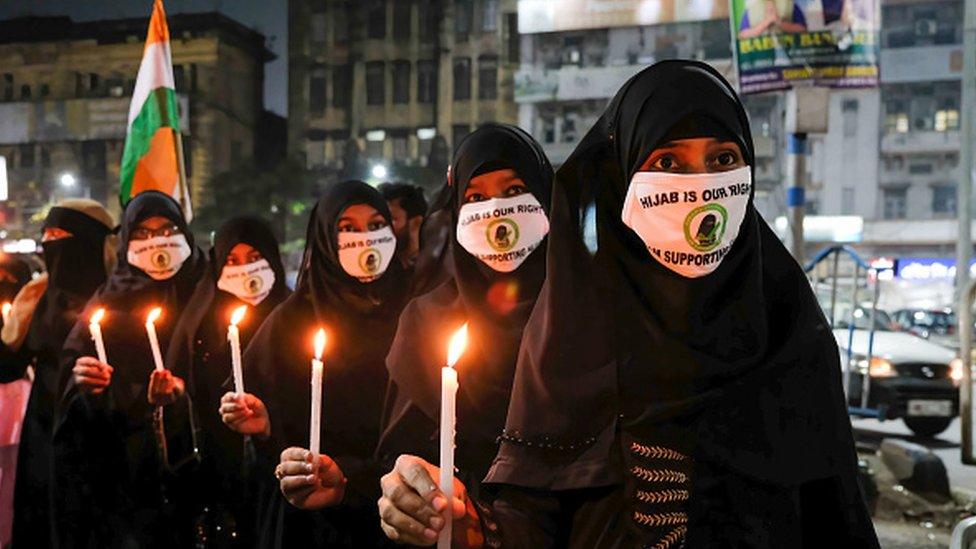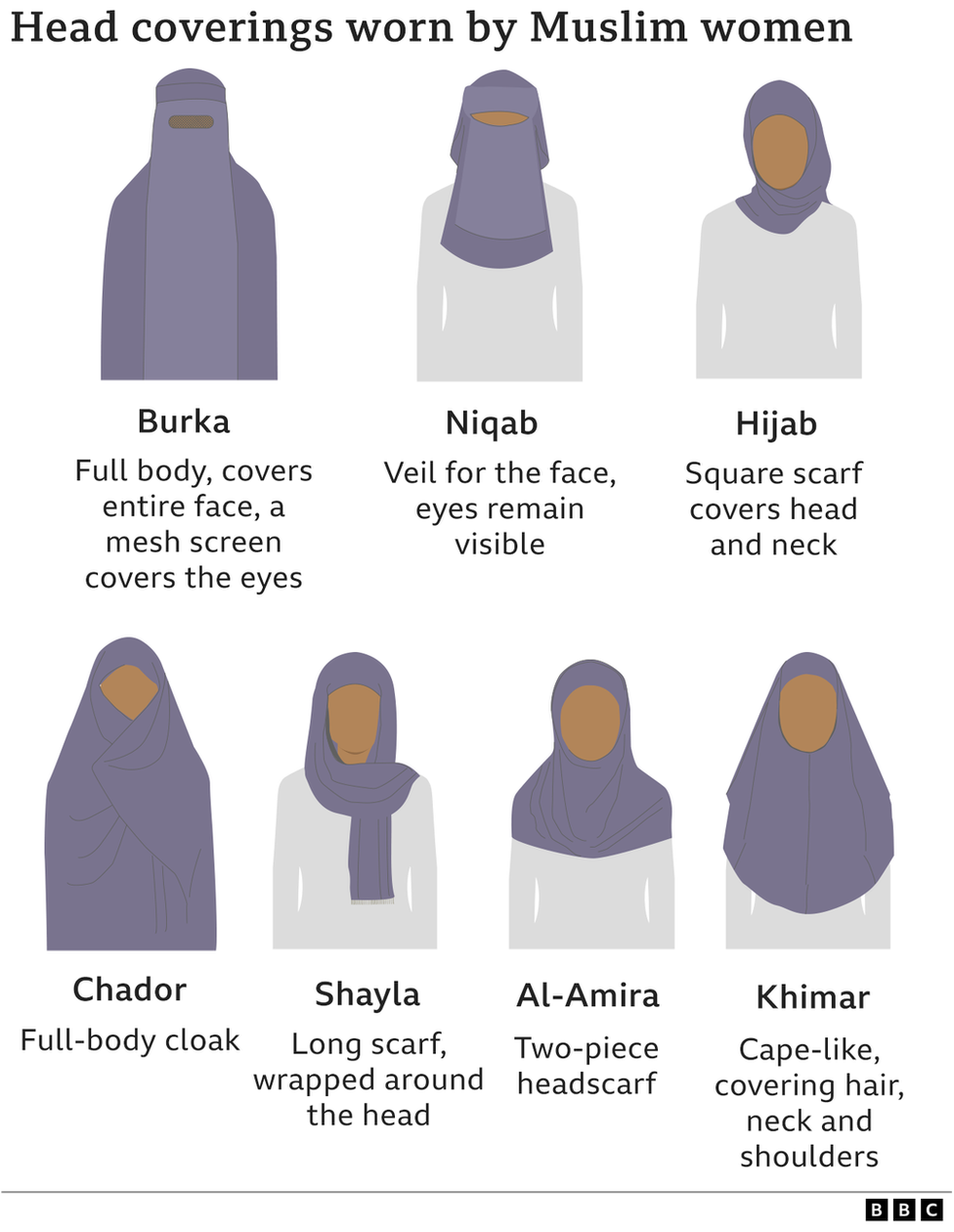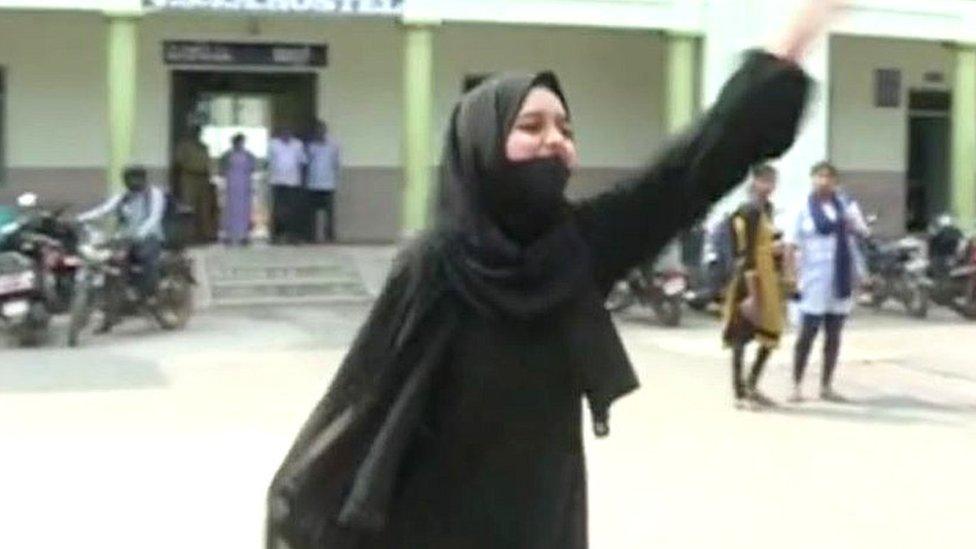Hijab verdict: India Supreme Court split on headscarf ban in classrooms
- Published

Muslim women in many parts of India protested against a Karnataka college decision to bar students from wearing hijabs
India's Supreme Court has failed to deliver a verdict on whether Muslim students can wear the hijab in schools and colleges, with two judges expressing opposing views.
One judge upheld a Karnataka high court order from March that said the hijab was not "essential" to Islam.
The other said the high court order was erroneous and wearing the hijab was a matter of choice.
The verdict was expected to cap a 10-month-long polarising debate in India.
But Thursday's development means the debate over the hijab will continue to consume the Indian public and the judiciary - as the judges could not agree on a decision, they have now requested the chief justice of India to recommend it to a larger bench.
The decision of Justice Hemant Gupta - who headed the two-judge bench - to uphold the high court order was widely expected. During the hearing, some of his comments had made headlines - he had told a lawyer arguing for the right to wear the hijab that "you can't take it to illogical ends" and asked him whether the "right to dress will include right to undress also?"
But Justice Sudhanshu Dhulia, the second judge, said in his order that the high court took a wrong path by focusing on whether the hijab was an essential religious practice and that wearing it was "ultimately a matter of choice - nothing more and nothing less".
The row began at the start of the year in the southern state of Karnataka when a government college in Udupi district barred six Muslim girls from wearing the hijab in class.
The college said it had only asked the students to remove the hijab inside the classroom - they could still wear it around the campus. But the girls, who wore the college uniform - a loose tunic with trousers and a shawl - said they should also be allowed to cover their hair in the classroom as they had "a few male teachers".
After the teenaged students protested against the ban, Hindu students started turning up in colleges wearing saffron scarves - the colour associated with Hinduism - and right-wing groups on both sides made provocative statements. Protests by saffron-clad Hindu students were also held in other states. Fearing violence, the Karnataka government shut down high schools and colleges for some days.
Muslim women protesters then challenged the ban in court, saying it was discriminatory and went against their right to freedom of expression and religion. They said that India's constitution gave them the right to dress as they pleased and that their faith required them to cover their head.
The government argued that the state had the right to prescribe school and college uniforms and also questioned their claim that the hijab was essential to their religion.
The trial court agreed that the government had the right to prescribe uniforms for students and barred hijab-clad girls from classrooms.


The Karnataka high court - which upheld the order on appeal - quoted from the Quran and other Islamic religious texts to say that wearing the hijab was not an essential religious practice and not wearing one did not make anyone "a sinner".
The order led several Muslim women to skip classes and even their exams. The row also polarised opinions - Karnataka is ruled by the Hindu nationalist Bharatiya Janata Party (BJP) and critics called it yet another attempt at marginalising Muslims since the BJP, led by Prime Minister Narendra Modi, came to power in India in 2014.
Nobel Prize-winner Malala Yousafzai, who was 15 when she survived an attack by the Taliban in Pakistan for speaking up for the right of girls to be educated, also weighed in on the debate, calling on India's leaders to do something to "stop the marginalisation of Muslim women".
The court case in India is being keenly watched globally as it comes at a time when protests over the hijab have also been sweeping Iran - although women there are fighting for their right to not wear headscarves.
Protests against the clerical establishment began after the death last month of Mahsa Amini, a Kurdish woman from the western city of Saqqez who fell into a coma after being detained by morality police in Tehran for allegedly violating the strict hijab law.
Since then, Iranian women have burned their hijabs on bonfires and women, including celebrities, from around the world, have posted videos of themselves cutting their hair in solidarity with the protesters.
The unrest is now considered the most serious challenge to the Islamic Republic since its inception in 1979. Rights activists say at least 154 people have been killed, external by government forces so far.

Read more India stories from the BBC:

Related topics
- Published10 February 2022
